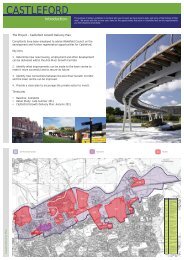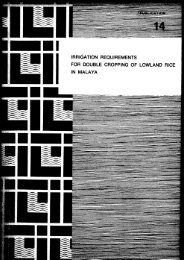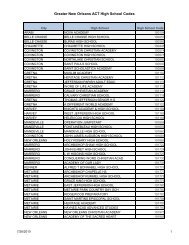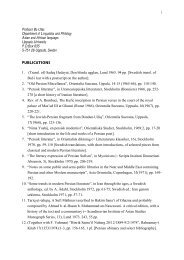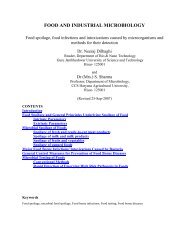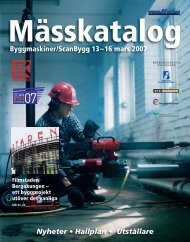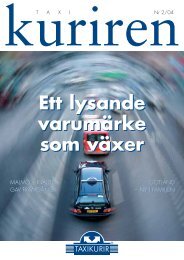On the Future of Indigenous Traditions - Munin
On the Future of Indigenous Traditions - Munin
On the Future of Indigenous Traditions - Munin
Create successful ePaper yourself
Turn your PDF publications into a flip-book with our unique Google optimized e-Paper software.
<strong>the</strong> Kuar, <strong>the</strong> Lal, <strong>the</strong> Thakur, <strong>the</strong> Karta, <strong>the</strong> Dewan, <strong>the</strong> Ohdar, <strong>the</strong> panre, <strong>the</strong> Kotwar,<br />
and <strong>the</strong> Sipahis – titles imitate <strong>the</strong> Hindu Rajas and Jagirdars. 48<br />
The land ownership, use, and management system, both within <strong>the</strong> Manki Pattis and<br />
o<strong>the</strong>r khuntkatti as well as <strong>the</strong> Bhuinhari Patti is directly linked to <strong>the</strong> customary<br />
system’s structure. This is <strong>the</strong> administrative system which all <strong>the</strong> Adivasis follow, if<br />
<strong>the</strong>y have not fully alienated <strong>the</strong>mselves from <strong>the</strong>ir ancestral lands. The categories <strong>of</strong><br />
land and its usages can range from four to seven or more within this system.<br />
However, <strong>the</strong> two broad categories, one that belongs to <strong>the</strong> Munda and Manki Pattis /<br />
side and <strong>the</strong> o<strong>the</strong>r belong to <strong>the</strong> Bhuinhari Patti / side are worth mentioning.<br />
The khuntkatti land is <strong>the</strong> land <strong>of</strong> <strong>the</strong> descendents <strong>of</strong> <strong>the</strong> original founders <strong>of</strong> that<br />
village and <strong>the</strong> lands <strong>the</strong>ir kith and kin have inherited 49 . The Bhuinhari land is <strong>the</strong><br />
land <strong>of</strong> <strong>the</strong> o<strong>the</strong>r common members / citizens (both Adivasis and <strong>the</strong>ir service<br />
communities who have settled with <strong>the</strong>m, i.e. potters, black smith, musicians, weavers<br />
and o<strong>the</strong>r such – part <strong>of</strong> <strong>the</strong> Hindu caste descendents who have become a part <strong>of</strong> <strong>the</strong><br />
Adivasi village community and a part <strong>of</strong> <strong>the</strong>ir social system).<br />
Among <strong>the</strong> Santals, Archer says, “If we seek an analogy to <strong>the</strong> Santal village<br />
community, we shall find it, surprisingly in <strong>the</strong> English modern state. Each presents a<br />
blend <strong>of</strong> ultimate democracy with influential leaders, <strong>of</strong> private ownership with<br />
moderate socialism, <strong>of</strong> citizens with claims and a community with rights. The first<br />
aspect <strong>of</strong> Santhal socialism is <strong>the</strong> public ownership <strong>of</strong> land…” 50<br />
2.3.3. Powers <strong>of</strong> <strong>the</strong> customary law<br />
The different kilis among <strong>the</strong> Mundas form a collective parha patti (among Oraos it is<br />
slightly different, but among Santhals, Hos and Kharias is – as I understand is same as<br />
Mundas) which includes <strong>the</strong> parha head, <strong>the</strong> pahan, <strong>the</strong> manki and <strong>the</strong> pat munda.<br />
48<br />
S. C. Roy, Op.Cit. 262.<br />
49<br />
Fidelis De Sa, Crisis in Chota Nagpur (Bangalore: A Redemptorist Publication, 1975), 6.<br />
50<br />
W.G. Archer, Tribal Law and Justice: A report on <strong>the</strong> Santhal (New Delhi: Concept Publishing<br />
Company, 1984), 25.<br />
38



